sensor TOYOTA C_HR HYBRID 2016 Workshop Manual
[x] Cancel search | Manufacturer: TOYOTA, Model Year: 2016, Model line: C_HR HYBRID, Model: TOYOTA C_HR HYBRID 2016Pages: 712, PDF Size: 49.31 MB
Page 337 of 712
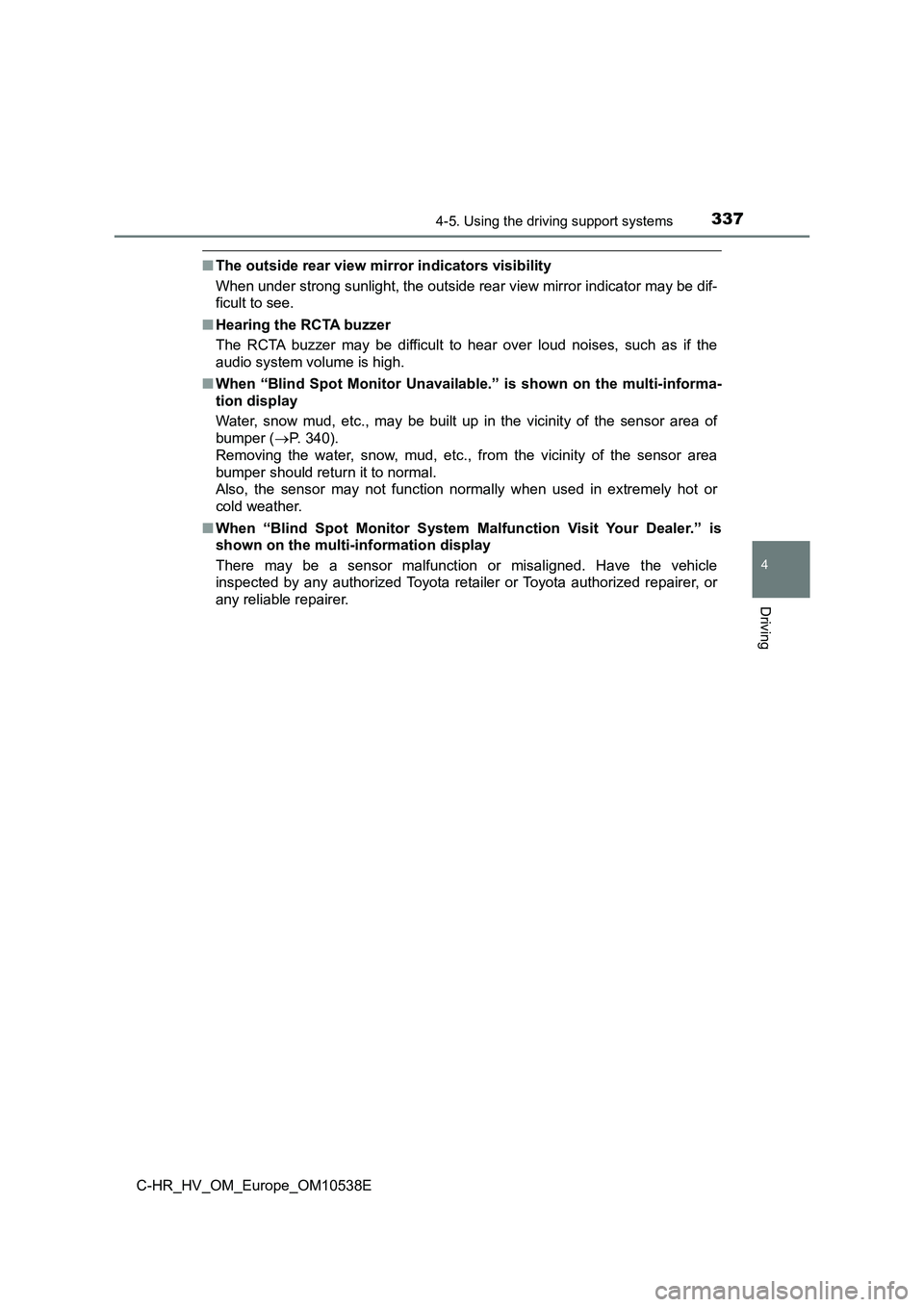
3374-5. Using the driving support systems
4
Driving
C-HR_HV_OM_Europe_OM10538E
■The outside rear view mirror indicators visibility
When under strong sunlight, the outside rear view mirror indicator may be dif-
ficult to see.
■ Hearing the RCTA buzzer
The RCTA buzzer may be difficult to hear over loud noises, such as if the
audio system volume is high.
■ When “Blind Spot Monitor Unavailable.” is shown on the multi-informa-
tion display
Water, snow mud, etc., may be built up in the vicinity of the sensor area of
bumper ( P. 340).
Removing the water, snow, mud, etc., from the vicinity of the sensor area
bumper should return it to normal.
Also, the sensor may not function normally when used in extremely hot or
cold weather.
■ When “Blind Spot Monitor System Malfunction Visit Your Dealer.” is
shown on the multi-information display
There may be a sensor malfunction or misaligned. Have the vehicle
inspected by any authorized Toyota retailer or Toyota authorized repairer, or
any reliable repairer.
Page 340 of 712
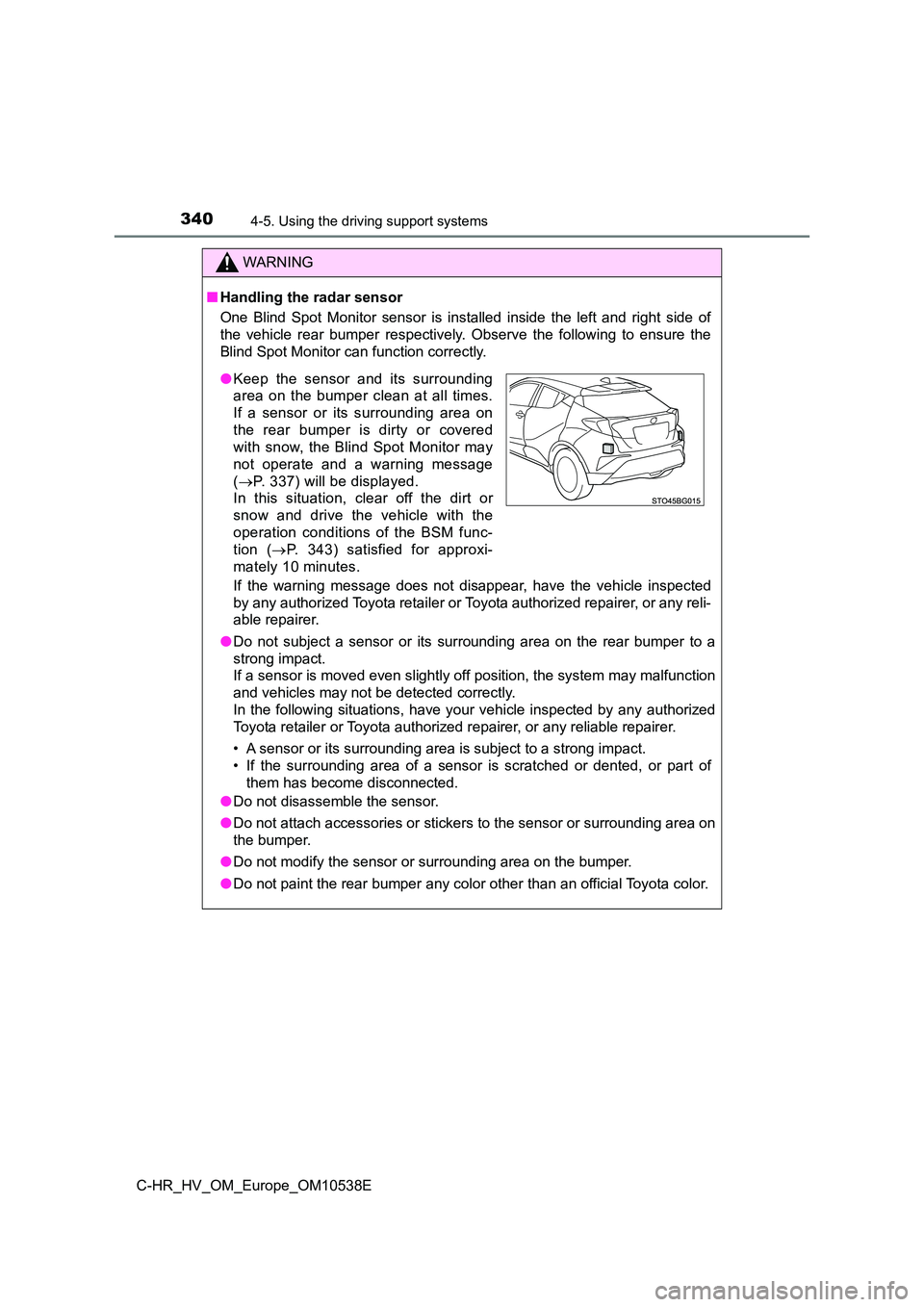
3404-5. Using the driving support systems
C-HR_HV_OM_Europe_OM10538E
WARNING
■Handling the radar sensor
One Blind Spot Monitor sensor is installed inside the left and right side of
the vehicle rear bumper respectively. Observe the following to ensure the
Blind Spot Monitor can function correctly.
If the warning message does not disappear, have the vehicle inspected
by any authorized Toyota retailer or Toyota authorized repairer, or any reli-
able repairer.
● Do not subject a sensor or its surrounding area on the rear bumper to a
strong impact.
If a sensor is moved even slightly off position, the system may malfunction
and vehicles may not be detected correctly.
In the following situations, have your vehicle inspected by any authorized
Toyota retailer or Toyota authorized repairer, or any reliable repairer.
• A sensor or its surrounding area is subject to a strong impact.
• If the surrounding area of a sensor is scratched or dented, or part of
them has become disconnected.
● Do not disassemble the sensor.
● Do not attach accessories or stickers to the sensor or surrounding area on
the bumper.
● Do not modify the sensor or surrounding area on the bumper.
● Do not paint the rear bumper any color other than an official Toyota color.
●Keep the sensor and its surrounding
area on the bumper clean at all times.
If a sensor or its surrounding area on
the rear bumper is dirty or covered
with snow, the Blind Spot Monitor may
not operate and a warning message
( P. 337) will be displayed.
In this situation, clear off the dirt or
snow and drive the vehicle with the
operation conditions of the BSM func-
tion ( P. 343) satisfied for approxi-
mately 10 minutes.
Page 341 of 712
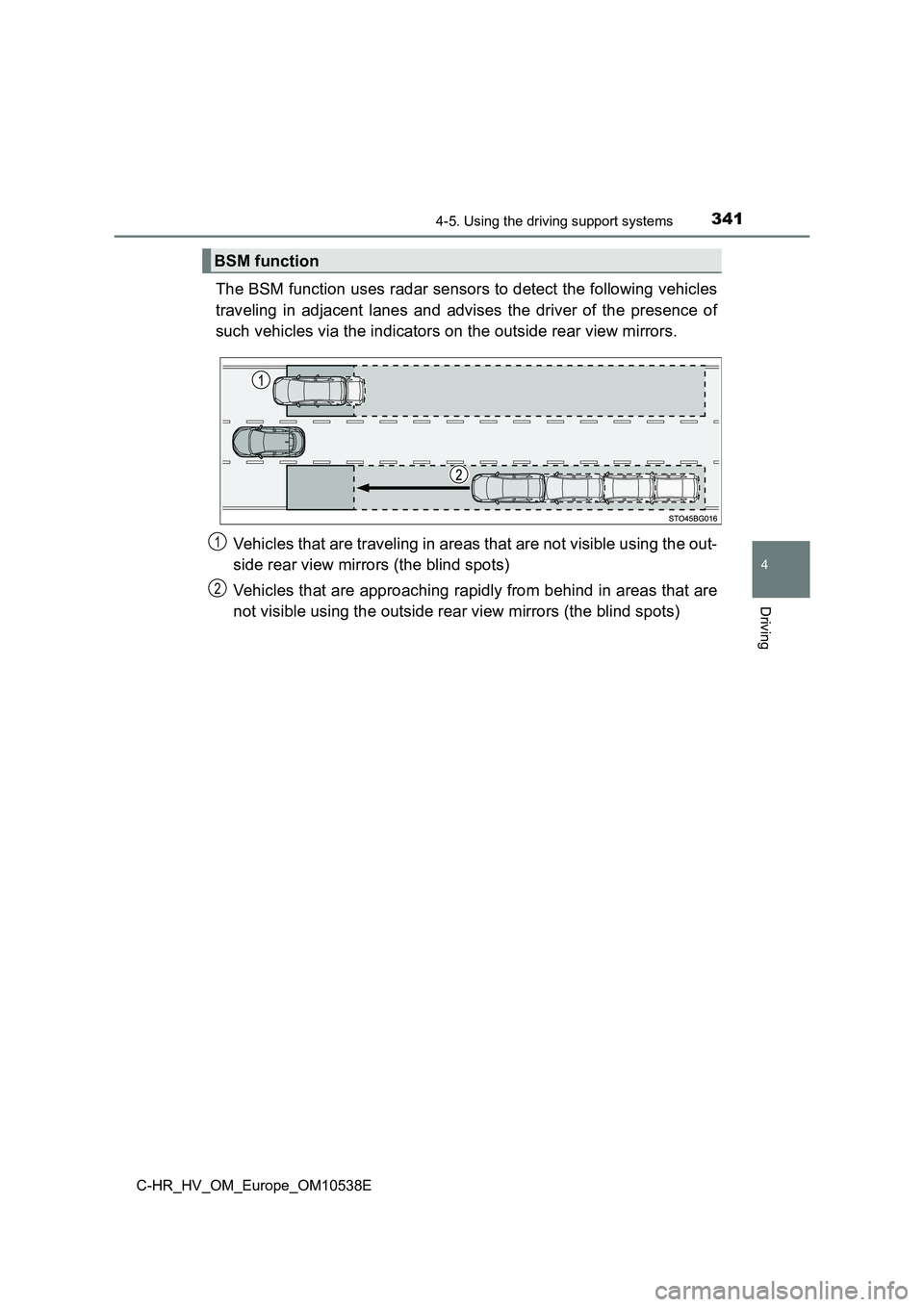
3414-5. Using the driving support systems
4
Driving
C-HR_HV_OM_Europe_OM10538E
The BSM function uses radar sensors to detect the following vehicles
traveling in adjacent lanes and advises the driver of the presence of
such vehicles via the indicators on the outside rear view mirrors.
Vehicles that are traveling in areas that are not visible using the out-
side rear view mirrors (the blind spots)
Vehicles that are approaching rapidly from behind in areas that are
not visible using the outside rear view mirrors (the blind spots)
BSM function
1
2
Page 344 of 712
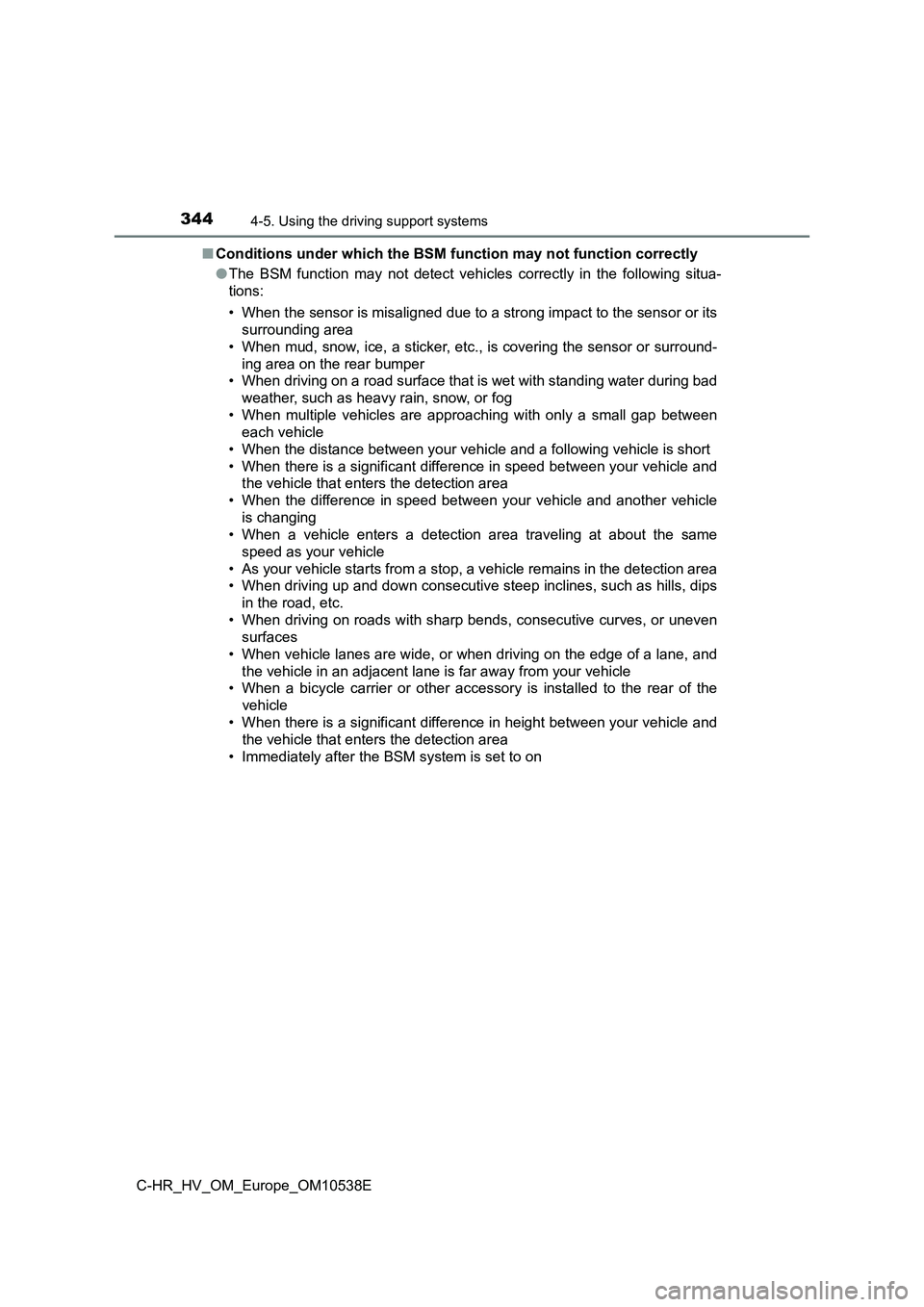
3444-5. Using the driving support systems
C-HR_HV_OM_Europe_OM10538E
■ Conditions under which the BSM function may not function correctly
● The BSM function may not detect vehicles correctly in the following situa-
tions:
• When the sensor is misaligned due to a strong impact to the sensor or its
surrounding area
• When mud, snow, ice, a sticker, etc., is covering the sensor or surround-
ing area on the rear bumper
• When driving on a road surface that is wet with standing water during bad
weather, such as heavy rain, snow, or fog
• When multiple vehicles are approaching with only a small gap between
each vehicle
• When the distance between your vehicle and a following vehicle is short
• When there is a significant difference in speed between your vehicle and
the vehicle that enters the detection area
• When the difference in speed between your vehicle and another vehicle
is changing
• When a vehicle enters a detection area traveling at about the same
speed as your vehicle
• As your vehicle starts from a stop, a vehicle remains in the detection area
• When driving up and down consecutive steep inclines, such as hills, dips
in the road, etc.
• When driving on roads with sharp bends, consecutive curves, or uneven
surfaces
• When vehicle lanes are wide, or when driving on the edge of a lane, and
the vehicle in an adjacent lane is far away from your vehicle
• When a bicycle carrier or other accessor y is installed to the rear of the
vehicle
• When there is a significant difference in height between your vehicle and
the vehicle that enters the detection area
• Immediately after the BSM system is set to on
Page 345 of 712
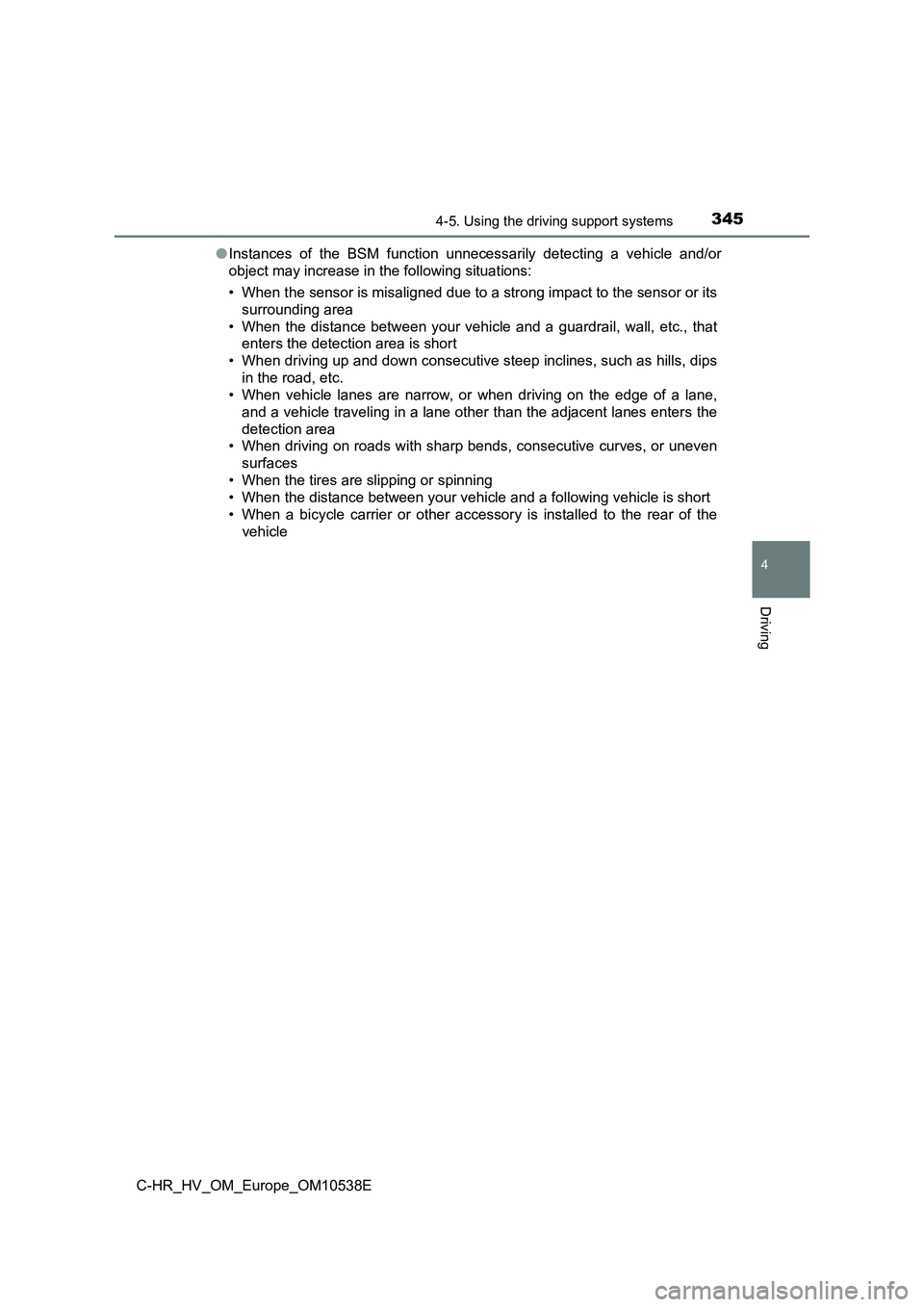
3454-5. Using the driving support systems
4
Driving
C-HR_HV_OM_Europe_OM10538E
● Instances of the BSM function unnecessarily detecting a vehicle and/or
object may increase in the following situations:
• When the sensor is misaligned due to a strong impact to the sensor or its
surrounding area
• When the distance between your vehicle and a guardrail, wall, etc., that
enters the detection area is short
• When driving up and down consecutive steep inclines, such as hills, dips
in the road, etc.
• When vehicle lanes are narrow, or when driving on the edge of a lane,
and a vehicle traveling in a lane other than the adjacent lanes enters the
detection area
• When driving on roads with sharp bends, consecutive curves, or uneven
surfaces
• When the tires are slipping or spinning
• When the distance between your vehicle and a following vehicle is short
• When a bicycle carrier or other accessor y is installed to the rear of the
vehicle
Page 346 of 712

3464-5. Using the driving support systems
C-HR_HV_OM_Europe_OM10538E
The RCTA functions when your vehicle is in reverse. It can detect
other vehicles approaching from the right or left rear of the vehicle. It
uses radar sensors to alert the driver of the other vehicle’s existence
through flashing the outside rear view mirror indicators and sounding
a buzzer.
RCTA function
Approaching vehicles Detection areas
WARNING
■ Cautions regarding the use of the function
The driver is solely responsible for safe driving. Always drive safely, taking
care to observe your surroundings.
The RCTA function is only a supplement ary function which alerts the driver
that a vehicle is approaching from the right or left at the rear of the vehicle.
As the RCTA function may not functi on correctly under certain conditions,
the driver’s own visual confirmation of safety is necessary. Over reliance on
this function may lead to an accident resulting death or serious injury.
12
Page 348 of 712

3484-5. Using the driving support systems
C-HR_HV_OM_Europe_OM10538E
■The RCTA function is operational when
The RCTA function operates when all of the following conditions are met:
● The BSM system is set to on. (P. 336)
● The shift lever is in R.
● Vehicle speed is less than approximately 8 km/h (5 mph).
● Approaching vehicle speed is between approximately 8 km/h (5 mph) and
28 km/h (18 mph).
■ Conditions under which the RCTA function will not detect a vehicle
The RCTA function is not designed to detect the following types of vehicles
and/or objects:
● Vehicles approaching from directly behind
● Vehicles backing up in a parking space next to your vehicle
● Guardrails, walls, signs, parked vehicles and similar stationary objects*
●Small motorcycles, bicycles, pedestrians, etc.*
●Vehicles moving away from your vehicle
● Vehicles approaching from the parking spaces next to your vehicle*
*: Depending on the conditions, detection of a vehicle and/or object may
occur.
● Vehicles that the sensors cannot detect
due to obstructions
Page 349 of 712

3494-5. Using the driving support systems
4
Driving
C-HR_HV_OM_Europe_OM10538E
■ Conditions under which the RCTA function may not function correctly
● The RCTA function may not detect vehicles correctly in the following situa-
tions:
• When the sensor is misaligned due to a strong impact to the sensor or its
surrounding area
• When mud, snow, ice, a sticker, etc., is covering the sensor or surround-
ing area on the rear bumper
• When driving on a road surface that is wet with standing water during bad
weather, such as heavy rain, snow, or fog
• When multiple vehicles are approaching with only a small gap between
each vehicle
• When a vehicle is approaching at high speed
• When backing up on a slope with a
sharp change in grade
• When backing out of a shallow angle
parking spot
Page 350 of 712

3504-5. Using the driving support systems
C-HR_HV_OM_Europe_OM10538E
• Immediately after the RCTA function is set to on
• Immediately after the hybrid system is started with the RCTA function is
set to on
● Instances of the RCTA function unnecessarily detecting a vehicle and/or
object may increase in the following situations:
• When a vehicle passes by the side of your vehicle
• When the distance between your vehicle and metal objects, such as a
guardrail, wall, sign, or parked vehicle, which may reflect electrical waves
toward the rear of the vehicle, is short
• When the sensors cannot detect a
vehicle due to obstructions
• When the parking space faces a
street and vehicles are being driven
on the street
Page 351 of 712
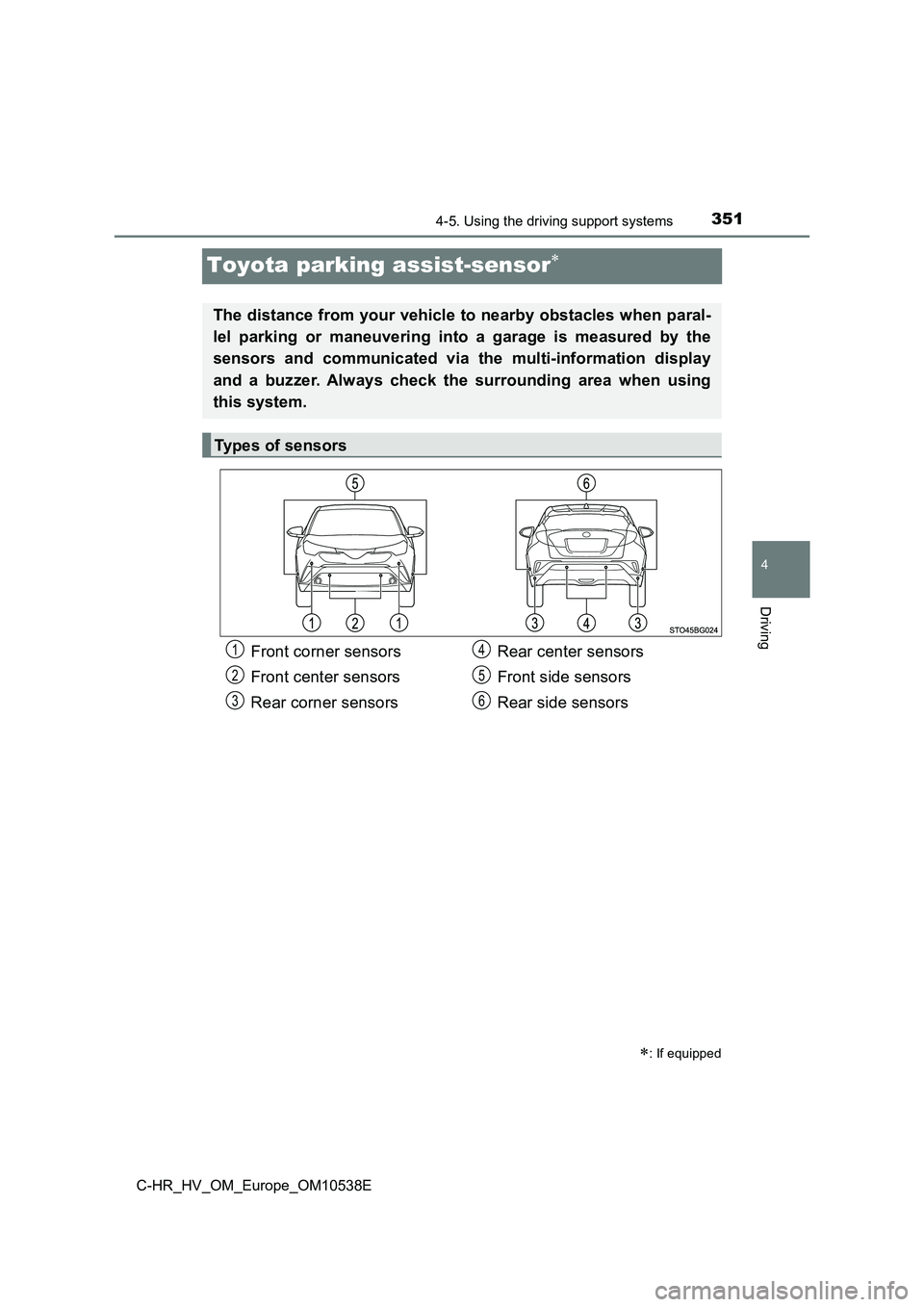
351
4
4-5. Using the driving support systems
Driving
C-HR_HV_OM_Europe_OM10538E
Toyota parking assist-sensor
: If equipped
The distance from your vehicle to nearby obstacles when paral-
lel parking or maneuvering into a garage is measured by the
sensors and communicated via the multi-information display
and a buzzer. Always check the surrounding area when using
this system.
Types of sensors
Front corner sensors
Front center sensors
Rear corner sensors
Rear center sensors
Front side sensors
Rear side sensors
1
2
3
4
5
6